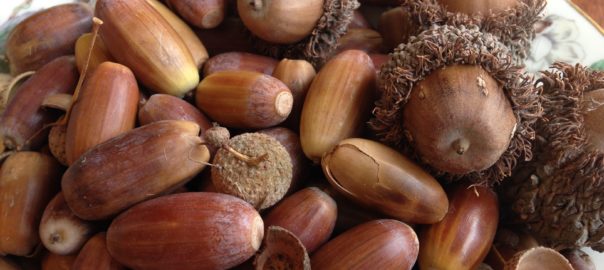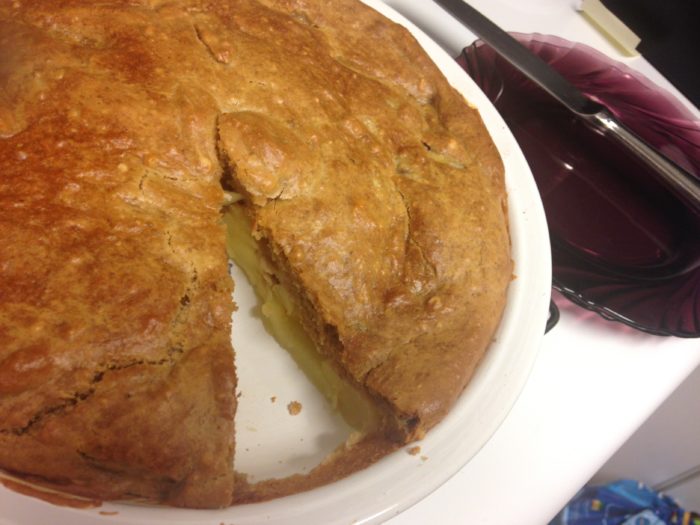Now that it’s Fall, I’m discovering smooth, brown acorns around the oak trees in the neighborhood. I think they’re so pretty! I wondered how to prepare and eat acorn as a wild-foraged food, even though I live in a city. One source said that acorns were eaten more commonly in the past than wheat and rice combined! Acorns were historically eaten on four continents: New England and dry California, Europe, Asia, and even northern Africa.(1) Isn’t hat amazing? They are a nutritious food source, and work well as a cooking binder, similar to wheat products.
Acorns are Plentiful, Free Food:
One video producer estimated there was over 88 pounds’ from one oak tree alone based on his gathering sampling of 8.8 pounds (250 grams) in 1 square meter. And because there were seventy-five large oak trees in one area, he was wondering why we weren’t utilizing this wild-foraged harvest as large as 3 tons!(4) (All video sources included at end of article, so you can watch them, too!) However, they are eaten by deer, squirrels, and other forest animals, so they’re not going to waste.
Acorn Nutrition Information- Vitamins and Minerals:
According to Arthur Haines, acorns are rich in nutrition: calcium, potassium, B vitamins, phosphorous. They have all eight essential amino acids (essential meaning that we need to eat these substances for fuel to build our own body proteins.)
One video producer, brawny03, said that a mere one ounce has 142 calories, 9 grams of fat and 2.3 grams protein. Historically, we needed a lot of fat to get through winter, even though our metabolism became slower during cold months. Today we still need fats for every cell wall in our bodies, brain function and more.
Check out my Transform online store for homeopathy treatment charts to use at home and on the go for First Aid Care (Homeopathy for Acute Conditions) and Colds & Flus, plus some nifty custom, caffeine-free herbal teas!! (I am in the process of setting up shipping) The Cold and Flu Homeopathy Chart uses a write-on/wipe-off marker to help adults and parents arrive at the right remedy.
Acorns are high in Omega 6 Essential Fatty Acid (EFA), which we can’t make in our bodies, but have to eat. This EFA is good, because its in a natural state, but most of us get too many Omega 6 EFA’s already from grains in our diets and our meat & dairy animals’ feeds. Omega 6 EFA’s are best if eaten with ample amounts of Omega 3 EFA, which is found in plants like flax seed and purslane herb, as well as wild and grass-fed (pastured) animal meats and dairy. But historically, food and fats were scarce, and most hunted animals were wild game anyway, and already high in Omega 3’s.
I found these beautiful acorns around several oak trees at our local mall, of all places! They were on a parking island. They’re really pretty. I found two kinds: long and thin, and wide and round.

I found two acorn types in the neighborhood: long and narrow and round and wide with fuzzy cap.
If you would like to receive my free Transform Health monthly newsletter, with the latest health, nutrition, herbal medicine news, and free recipes for special diets and everyone else, please sign up here in 30 seconds.
Different Kinds of Oak Species:
According to Arthur Haines, there are two kinds of oak trees and acorns: black oaks and white oaks. Black oaks have a sharp end lobe on their leaf tip, the acorns have hairs inside the shell, and have a long collection season from Fall through Spring. I think he said that they ripen over a longer period, as well. This makes them super important historically, when food may have been scarce after October. Black oak acorns also dry more easily, and are less prone to spoilage than the White oak acorns.
White oaks have a blunt tip lobe on their leaf tip, no hairs inside the acorn shells. They have a shorter collection season because they drop all at once in Fall. And they are more prone to spoilage. There were other species differences on the leaf sides, too.

On each side are the oak leaves matched with their different acorn types.
Within each of these two species there are many different kinds of oaks. They vary the world over as to the growing environment that they like, some preferring drier conditions, some liking having wet “feet.”
If you would like to receive my free Transform Health monthly newsletter, with the latest health, nutrition, herbal medicine news, and free recipes for special diets and everyone else, please sign up here in 30 seconds.
How to Harvest Acorns: Wild Food Foraging Instructions for the Collector:
Video producer Arthur Haines recommends avoiding collecting acorns with holes, caps still on (shows they are immature), and those with black streaks, which can show that fungus is present. Video producer Green Deane recommends avoiding eating green acorns, and waiting until they ripen (turn brown in color) before eating them.

Acorns that have fallen down to the ground with the caps still on shows that there is something wrong with them. The yellow acorns aren’t ripened yet. They will turn brown in time.
Tannins/ Tannic acid in Acorn Nuts:
Before being eaten, acorns need to be soaked in several changes of either hot or cold water to neutralize two things: 1) phytic acid, an anti-nutrient that becomes a phytate, binding to our vitamins and minerals and washing them out of the body, as well as 2) the bitter taste of tannins in the nuts. In the videos, people soaked (or leached) the acorns either whole in the shell or after grinding during their processing to remove the tannins. (Just FYI, phytic acid is found in all seeds and nuts, including our grains. We’ve just forgotten how to neutralize them through soaking, sprouting and sourdough processes. See cite 5 below to read more about this.)
According to Green Deane in his YouTube video channel “Eat the Weeds”, the larger the cap size to nut generally shows that they have more tannic acid. He collected or foraged acorns from a neighborhood Live Oak, explaining that hardly any leeching was needed as they were just not as bitter as other species. (I’m not sure where he filmed his video, but I know that Live Oaks grow in southern California with dark glossy leaves and great outstretched arms. They look cool and sinister in dusk light.)
How to Process Acorns to Eat as Food, According to Arthur Deane:
The most elaborate and traditional method was in the video by Arthur Deane, who used traditional preparation methods used by Native Americans with cold water leeching. Dried acorns store a very long time in the shell: two to three years! Important Tip: He said that acorns are much easier to shell after they’ve been dried, as the inner nut shrinks in a bit, and loosens from the outer shell. In fact, I saw another Youtube video (not cited), and the creator was trying to shell green acorns. It was a slow process with a lot of grousing.
If you would like to receive my free Transform Health monthly newsletter, with the latest health, nutrition, herbal medicine news, and free recipes for special diets and everyone else, please sign up here in 30 seconds.
Remove non-food bits from your acorn bag. Rinse them. Dry acorns in 1 layer in the sun for two weeks, bringing the acorns inside each night to avoid dew fall and on rainy days. (These instructions are for black oak acorns; white oak acorns take 2-3 times longer.)
If you’re going to store the acorns in the shell at this point, it’s recommended to store them in a cold dry place, as the high fat content can make them rancid.The video producer brawny03 said that you should eat them immediately if they start to germinate. However, she said that long sprouts (3/4″) were not good to eat.3
If you would like help on your health journey, I create personalized nutrition, lifestyle and herbal plans for clients. We can also have a free twenty minute phone call to see if we would be a good fit. Contact me via email [ContactUs @TransformHealth.Biz – just remove the spaces in this email] or phone: 970.988.5413 (in the US). I have video calls available, in addition to normal phone calls.
How to Shell Acorns for Food Eating:
Shell them like this: hold the acorn’s pointy end down into a wood board. Pound the blunt back end with a rock and the shell should break apart. Other people showed pliers or nut crackers in their videos, or hit them with a hammer on their side. Don’t worry about removing the red paper on the nut. Grind the acorns to a fine meal or flour size. Mr. Deane used a corn mill (grinder) that he ran the acorns through twice.1
How to Leach Tannins from Acorn Meal:
Then Mr. Deane put the meal into a large bowl (much larger than the meal), and added water to the rim. The meal sank to the bottom. Change the top water once or twice daily for 5 days to prevent spoilage. The acorn meal is done leaching when it stops tasting bitter or astringent (dry & tightening taste on the tongue). (Acceptable bowl materials include glass, porcelain and stainless steel.)1
Acorn Meal Preparation: Draining After Leaching:
Pour off the top water only into a drain, well above the sunken acorn meal on the bottom. Strain the rest of the acorn meal through a cloth-lined strainer, into a bowl. Gather the cloth and squeeze the water out well. Use the prepared acorn meal immediately, or dry it to use later. Brief recipes are below.
Check out my Transform online store for homeopathy treatment charts to use at home and on the go for First Aid Care (Homeopathy for Acute Conditions) and Colds & Flus, plus some nifty custom, caffeine-free herbal teas!! (I am in the process of setting up shipping) The Cold and Flu Homeopathy Chart uses a write-on/wipe-off marker to help adults and parents arrive at the right remedy.
Acorn Meal Drying Process:
Spread 1/4″ layer onto a flat baking sheet in the sun for a few days, or use a dehydrator for several days.1 (I am wondering how we can avoid having squirrels eat them at this point.) Avoid high temps until the cooking time. A different video producer said that if you introduce heat before the actual cooking time that the meal would lose its ability to stick together. I do know that if you heat soaked nuts over 150 degree Fahrenheit, that their enzymes are destroyed.4

Craft idea using acorns (I could not get this photo to rotate – many minutes trying!)
Acorn Drying, Shelling and Leaching According to ACampfireProduction:
The video by ACampfireProduction dried the acorns in the sun for 5 days. To shell them, he cut off the top and bottom ends crosswise while holding them sideways on a cutting board. Then he cut down into the acorn lengthwise and removed the shell. He put them into boiling water, and changed the top water for new water about 5 times or more. He didn’t really say how long he boiled them like that. From other videos, I learned that they are done boiling when they’ve lost the bitter tannin taste. This might come out as an “astringent” taste, drying to the tongue similar to black tea.
If you would like assistance on your health journey, I create personalized health, nutrition and lifestyle plans for clients. We can also have a free twenty minute phone call to see if we would be a good fit. Contact me via email [ContactUs @TransformHealth.Biz – just remove the spaces in this email] or phone: 970.988.5413 (in the US). I have video calls available, in addition to normal phone calls.
How to Dry Acorns:
Then this video host dried them in a small, dry pot. There was no duration given. (Alton Brown videos used to make fun of chefs who wrote, “Cook until done.” When was that?} The video producer then pounded the acorns into a flour using a wooden post and wooden metate. He made the acorn meal into a pancake, using these rough ingredients (no measures given): acorn meal, white flour, egg, milk, small amount honey. He fried the acorn meal pancakes for ten minutes in fat, presumably turning the pancake halfway through. He said it held together OK until the end. (This makes me wonder if the sickness factor goes away with overcooking, like it does for arrowroot powder.) The taste was sweeter than he would have thought, because he only used a bit of honey.
Leach Tannins from Acorns in Cold or Hot Water:
Green Deane from EattheWeeds.com recommended leaching the acorns or acorn meal in your choice of either only cold water or only hot water. Mixing the two methods would make the meal bind to the tannins, and leave in the bitter taste, so avoid this! He wanted us to avoid cooling them in the middle of the heating process, for instance. Heating them probably makes the acorn meal lose its binding/stickiness factor. And different people leached the tannins from the acorns either when whole or after grinding.
Check out my Transform online store for homeopathy treatment charts to use at home and on the go for First Aid Care (Homeopathy for Acute Conditions) and Colds & Flus, plus some nifty custom, caffeine-free herbal teas!! (I am in the process of setting up shipping) The Cold and Flu Homeopathy Chart uses a write-on/wipe-off marker to help adults and parents arrive at the right remedy.
Green Deane leeched his acorns whole, then dried them, shelled them, ground in the food processor, added water, and then strained the meal through a cloth and sieve into a bowl. He made the acorn meal into an Acorn Bannock, but didn’t give an actual recipe. (Bannock bread is an Irish baking soda-risen bread, with no yeast for the riser. It’s a “quick-bread.”) It looked like flour, baking soda, acorn meal, and water from the time in the food processor. He fried it in oil on both sides to make a flat bread. (Maybe you could get a bannock bread recipe and replace some flour with the acorn. It sounds like acorn has binding qualities, like its more flour-like in recipes. Nuts can only be used to replace a small amount in a recipe, because they don’t act the same as wheat gluten and other binders.)
Green Deane said that if you’re boiling the acorns, the fat will separate and rise to the top. It can then be taken off.
Next – Trying to Prepare Acorns Myself:
OK, the next step is trying this process myself. Wish me luck! If you want to join me, write in the comments section. I’ll write again to update you on what I discover from doing it hands-on.
If you enjoyed this recipe, please share it with your friends, using the social media buttons below.
Did you try it? What did you think? Let me know in the comments below. Thanks! Happy Cooking!
If you would like help on your health journey, I create personalized plans for clients. We can also have a free twenty minute phone call to see if we would be a good fit. Contact me via email [ContactUs @TransformHealth.Biz – just remove the spaces in this email] or phone: 970.988.5413 (in the US). I have video calls available, in addition to normal phone calls.
Video Bibliography:
- Video by Arthur Haines – From Tree to Table: Gathering and Using Acorns, www.ArthurHaines.com, a New England food forager
- Video by Green Deane, EattheWeeds YouTube channel, and website EattheWeeds.com: #50 – Acorns
- Video by brawny03 in Acorns as Survival Food
- Video by ACampfireProduction: Acorns – How to Prepare and Cook
- Book <a target=”_blank” href=”https://www.amazon.com/gp/product/0967089735/ref=as_li_tl?ie=UTF8&camp=1789&creative=9325&creativeASIN=0967089735&linkCode=as2&tag=transform44-20&linkId=b7c778528e626706161369d89819d8d9″>Nourishing Traditions</a><img src=”//ir-na.amazon-adsystem.com/e/ir?t=transform44-20&l=am2&o=1&a=0967089735″ width=”1″ height=”1″ border=”0″ alt=”” style=”border:none !important; margin:0px !important;” /> by Sally Fallon and Mary Enig
This post contains a few affiliate links, which did not affect the content or information listed here. Diana Sproul of Transform Health is a participant in the Amazon Services LLC Associates Program, an affiliate advertising program designed to provide a means for sites to earn advertising fees by advertising and linking to Amazon.com. This small affiliate payment helps me support this health education work, which a lot of information is offered for free to the public.


